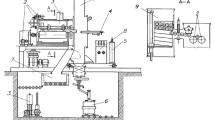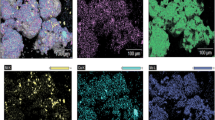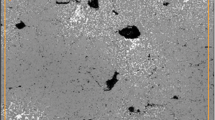Conclusions
An investigation was carried out into the effect of particle size of powders produced by comminution of R6M5 high-speed steel waste (swarf) on their compressibility and sinterability. It is shown that with decreasing mean particle size the compressibility of such powders deteriorates, but their sinterability improves. The finer the steel powder, the lower is the sintering temperature necessary for the attainment of a given density. Varying the powder particles size brings about marked changes in the microstructure of the steel in the sintered condition. The liquid phase (ledeburitic eutectic) appearing during the sintering of steel powders of different particle sizes varies in form and distribution. With coarse powders (dm=100 μm) the eutectic is similar to that in cast steel, but with powders of small particle size (dm=22 μm) it is finer and evenly distributed throughout the structure in the form of thin lamellae.
Similar content being viewed by others
Literature cited
Ya. L. Gipsh, V. B. Akimenko, and L. Kh. Strokovskii, “Production of high-speed steel by the powder metallurgy technique,” Chermetinformatsiya, No. 2, 1–12 (1979).
“New developments in the field of high-speed steels,” Stahl Eisen, No. 9 (1979).
O. N. Kirillova and Z. M. Fetisova, High-Productivity Tool Materials and Suitable Fields for Their Application: Nllinformenergmash Institute Survey [in Russian], Moscow (1977).
A. K. Petrov, A. G. Tsipunov, and V. B. Akimenko, “P/M high-speed tool steels,”Transactions of the 14th All-Union Conference on Powder Metallurgy Problems in the Manufacture of Parts for Engineering Applications [in Russian], Tashkent (1979), pp. 93–95.
S. S. Kiparisov, G. A. Meerson, V. S. Panov, et al., “Production of high-speed steel by the powder metallurgy technique,” Poroshk. Metall, No. 10, 27–30 (1975).
V. I. Tret'yakov, S. S. Kiparisov, V. S. Panov, and M. M. Smirnova, “ Investigation of the reduction and sintering of steel powder in hydrogen and in a vacuum,” Transactions of the 14th All-Union Conference on Powder Metallurgy Problems in the Manufacture of Parts for Engineering Applications [in Russian], Tashkent (1979), pp. 8–10.
V. I. Tret'yakov, Principles of the Metallurgy and Technology of Manufacture of Sintered Hard Metals [in Russian], Metallurgiya, Moscow (1976).
Author information
Authors and Affiliations
Additional information
A 0.85%C-6% W-5% Mo-4% Cr-2% V (nominal composition) high-speed steel — Translator.
The authors wish to thank A. N. Nikolaev of the Gorkii Polytechnic Institute for helpful discussion in the experimental part of the work.
Translated from Poroshkovaya Metallurgiya, No. 6(234), pp. 9–15, June, 1982.
Rights and permissions
About this article
Cite this article
Kiparisov, S.S., Tret'yakov, V.I., Panov, V.S. et al. Properties of R6M5 steel powders of various particle sizes and the structure of the steel in the sintered condition. Powder Metall Met Ceram 21, 431–436 (1982). https://doi.org/10.1007/BF00801749
Received:
Issue Date:
DOI: https://doi.org/10.1007/BF00801749




